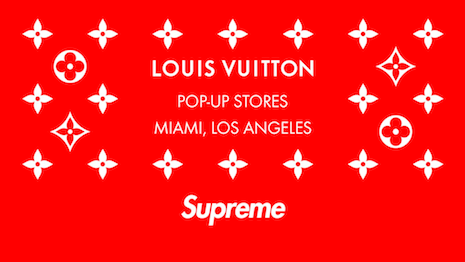 Once legal adversaries, Louis Vuitton and Supreme went on to form one of the most successful partnerships between a luxury brand and a premium label, adding sheen to both. Image credit: Louis Vuitton
Once legal adversaries, Louis Vuitton and Supreme went on to form one of the most successful partnerships between a luxury brand and a premium label, adding sheen to both. Image credit: Louis Vuitton
NEW YORK – At an Inner Circle CEO Roundtable luncheon hosted June 5 by The Monaco Government Tourist Office of New York, 14 Luxury Marketing Council members, CEOs and chief marketing officers explored the opportunities, challenges and case histories in creating partnerships with competing luxury brands.
Attendees included executives from Compass, Elite Traveler Media Group, IPZUSA, Keller Williams/The Edry Group, Layneau, MarieBelle Chocolates, Monaco Government Tourist Office, New Haven Consulting Group, Oomiji, Regal Threads LLC, Springut Law, The Center for Client Retention and The Luxury Marketing Council.
Enemies, frenemies, partners
Unique partnerships discussed at the event include:
- ViewFort Estate in Anguilla, a five-star private villa ($10,000 per night during peak season), is exploring partnerships with competing five-star hotels such as the Four Seasons and kitchen appliance maker Cuisinart to offer their best customers with opportunities to participate in pay-to-play experiential evenings at ViewFort Estate. Focusing on local culture, craft, art, food and music, these experiences will let ViewFort Estate drive brand awareness, while providing a unique experience to best customers of competing hotels.
- Most luxury brokers are open to sharing commissions and working together on a shared commission basis. It is more unusual in the luxury arena to co-broker luxury properties. Keller Williams Real Estate and competing broker Compass Real Estate are firm believers in routinely co-listing sales. Their slogan being, “co-broke or go broke.”
- All of the hotels in the Principality of Monaco have agreed jointly to participate in Monaco’s new carbon neutral initiative, “Green Is the New Glam,” their vision being to make all hotels in Monaco carbon neutral by 2050. This partnership between competing hotels emphasizes the need for corporate social responsibility and helps Monaco to the benefit all parties involved.
- Apple and Hermès, two brands with watch divisions, have partnered to offer a jointly-designed watch and offered this unique product to tap customers who are fashion conscious and tech savvy. This collaboration has helped both brands win new customers.
- After settling a contentious dispute around copyright design infringement, Louis Vuitton and Supreme partnered together to created a new line of street-smart products including apparel, luggage and accessories targeting their shared best customers.
Partnering with competing luxury brands is never easy and not for the faint of heart. Communications, understanding and creativity are paramount.
Challenges discussed at the event include:
- Training both partners’ sales associates to be open and “in the know”
Making sure both brands’ sales associates are trained to know their partner’s products and services as intimately as they know their own.
Truly focused on the best customer relationship and needs of the best customer, sales associates will be comfortable in recommending the best option. Knowing that best serving the best customer is in the interest of both brands. How compensation is handled in terms of who receives the commission on a sale needs to be worked out in advance between the partners.
- Handling incentives so that sales associates receive fair commissions on referral, upselling, and cross-selling
When a sale is referred by a co-opetive partner, the brand receiving the referral must have trust among the staff when cross selling and upselling, department to department, in the same way they would with their own best customers.
Everyone wins by sharing commissions on new best customers. Clearly, lines of communication must be open and sales associates need to be empowered to provide a seamless and enjoyable experience for the customer.
- Integrating online and in-store marketing
The voice and message online and in-store of both partner brands must be consumer friendly, integrated and consistent.
The smartest luxury marketers understand that all luxury brands share 60 percent of the best customers, just not the same 60 percent.
By creating strategic partnerships with like-minded luxury brands to share lists, track sales and jointly host events, luxury marketers can win more customers like their best customers.
Partnerships like these help build brand awareness, create special experiences and develop new ways to surprise and delight their shared best customers.
LUXURY BRANDS can no longer go it alone.
Strategic partnerships continue to be one of the most successful marketing strategies in growing revenues.
It is no longer just about competition. It is about co-opetition, ultimately, providing the best customer the most luxurious experiences possible through unique, out-of-the-box partnerships.
Christopher Olshan is CEO of the Luxury Marketing Council, New York. He is also founder and head distiller of Conestoga, PA-based Surly Penguin. Reach him at [email protected].
